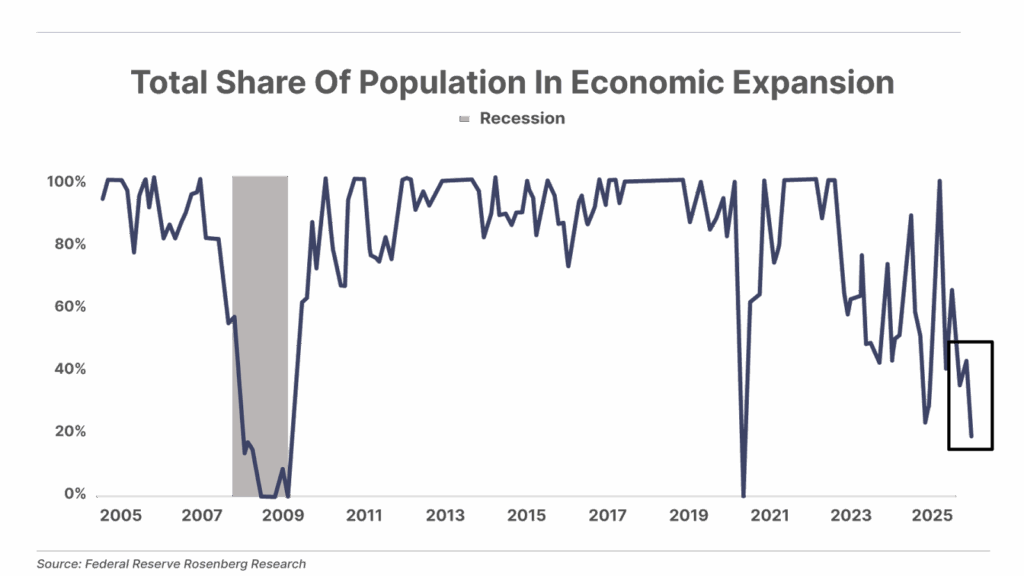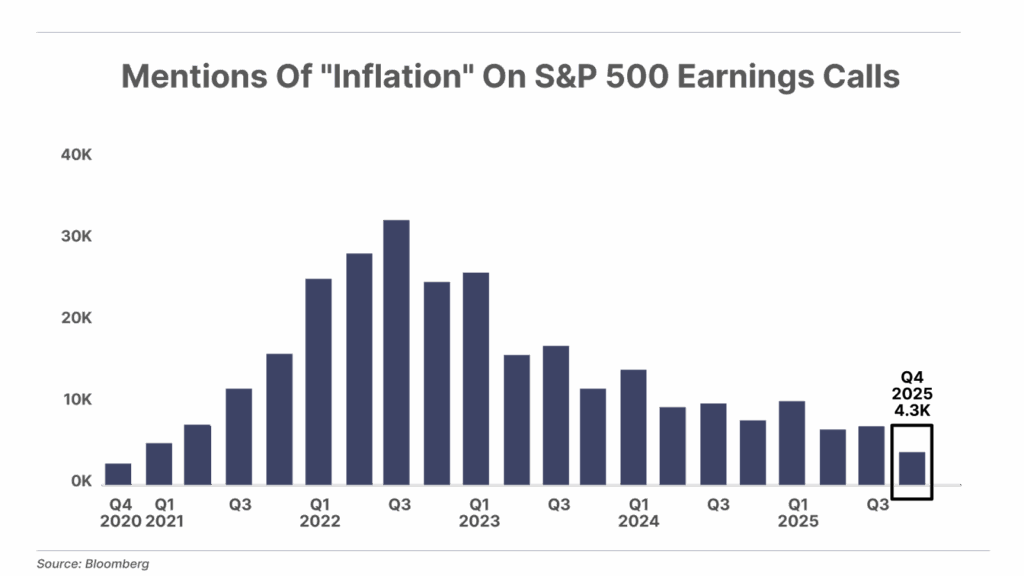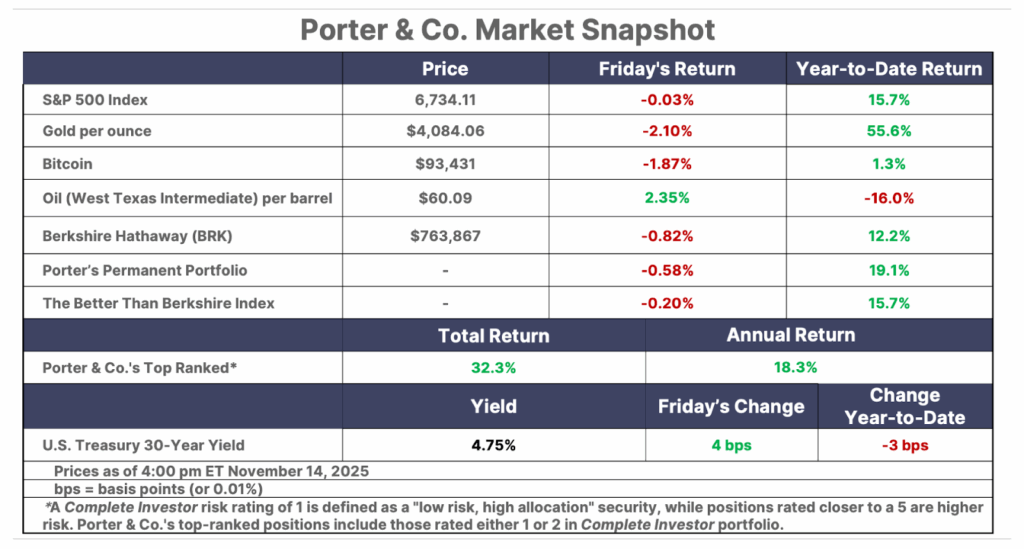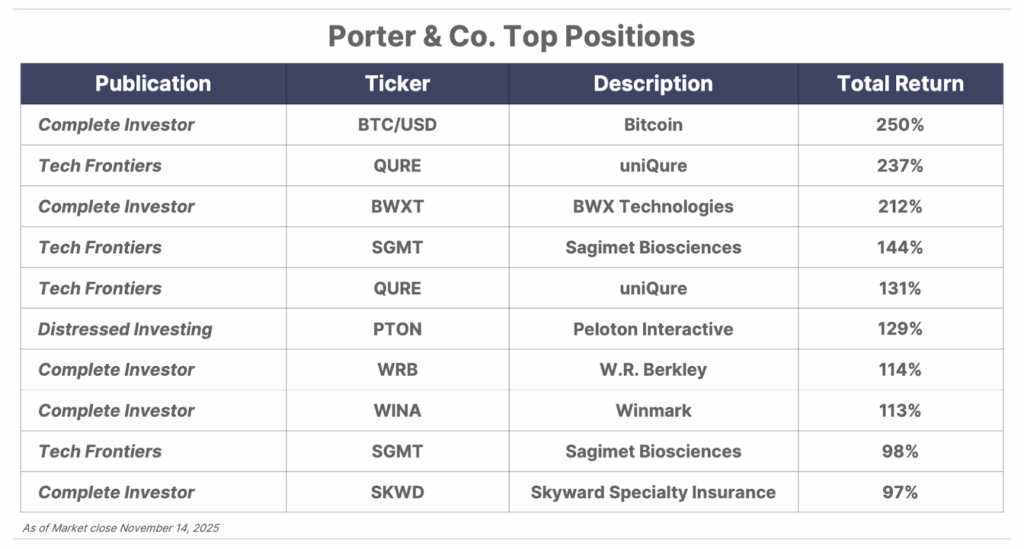Issue #133, Volume #2


The Information I Would Want If Our Roles Were Reversed
This is Porter’s Daily Journal, a free e-letter from Porter & Co. that provides unfiltered insights on markets, the economy, and life to help readers become better investors. It includes weekday editions and two weekend editions… and is free to all subscribers.
| Capital efficiency… Selling puts… Discounted bonds… Shorting a stock in a bear market… P&C insurance… McDonald’s, Coke, Hershey… It’s never too late to start… Recession is already here… Berkshire buys GOOG… |
I’m going to give you the one, big secret. It’s the only real, true secret of finance. And once you understand it, you won’t need us (or anyone else) ever again.
As longtime readers must be tired of hearing me say… I feel a huge responsibility to tell you what I would want to know if our roles were reversed. Some of you have paid us to help you make decisions about investing your hard-earned savings. We aren’t fiduciaries. We don’t offer any personalized investment advice, nor do we manage anyone’s money. But this doesn’t absolve us of responsibility to you. You deserve our best.
Over the years, I’ve explained a lot of Wall Street’s “secrets” – like how to manage risk, for example. And why “junk” bonds (high-yield corporate bonds) are sometimes vastly better investments than stocks. (For proof of that, just look at the track record of Marty Fridson’s Distressed Investing. Its recommendations are always among the top positions in the Top 10 Positions reported at the end of each Daily Journal.)
Likewise, we’ve covered why selling naked puts is almost always safer and more profitable than buying stocks outright – something I’d wager your broker would never explain.
Even more contrarian is our opinion that selling stocks short is a great way to reduce risk in your portfolio. This strategy has protected us in past bear markets, and we recently produced Porter’s Guide To Shorting A Stock for our paid-up Complete Investor subscribers.
And then, there are the basics we’ve covered dozens of times – like how important it is to be able to value a security before you buy it. The nominal price of a stock or the nominal coupon of a bond is completely useless as an indicator of value. If you don’t understand exactly why this is so, please… do yourself a favor… don’t own any securities. You should never own anything you don’t understand.
These concepts – discounted bonds, shorting stocks, valuation, trailing stop losses, and selling puts – are critical to active investors. They all play a role in giving you the tools you need to increase your returns. You ought to know all about them and be able to use them tactically to take advantage of opportunities in the market. I’ve written about these concepts many times over the years. And I’ve probably said they’re the “most important” thing I could teach you from time to time. I wasn’t lying.
Earlier this year, we launched The Trading Club. In our first sessions, Ross Hendricks and I urged subscribers to begin selling puts. It was the best tactical opportunity I’d ever seen. I promised that we’d make double-digit returns – and we did!
Believe me… having this tool bag and knowing when to use these strategies will make you a much better investor. It will allow you to profit from opportunities the market always creates. But… how can you learn to be patient enough to wait for these opportunities? That’s what I’d like to show you today. The real secret is in this one…
So what’s the most important idea I’ve discovered in finance? What’s the one thing I’m going to teach my kids beyond the obvious stuff about saving, compounding, and risk management? What do I believe is the real secret to investment success? And… the biggest question of all… How do I invest my own money in securities?
Over the long sweep of your investing lifetime, strategies that only work extremely well in certain market situations are unlikely to play a dominant role. The big secret therefore is something you can use all of the time, for your entire life, as an investor. And here it is:
Some companies are much better than others at compounding capital. Much better.
If your goal as an investor is to compound your savings over time, wouldn’t it be easier to simply figure out which companies will compound your capital at an acceptable rate, buy those firms (and only those firms) at reasonable prices, and then do something else with the rest of your time?
Here’s a simple, but powerful example. Well-run insurance companies can produce what’s called an “underwriting profit.” They are literally paid money in advance to manage your capital. And they get to keep not only the investment profits, but profits from the premiums, too. That’s like paying the bank to keep and use your money. No other business can compound capital so consistently.
Insurance companies have other fantastic advantages, too. They’re able to legally defer most of their taxes. They’re nearly immune from economic factors. They’re scalable. I could go on. They’re a focus for us because well-run insurance companies are legendary compounders of capital. Buy them at a reasonable price, and it’s impossible not to do well.
We have recommended several property-and-casualty (P&C) companies in Complete Investor. Insurance stocks as a whole – as measured by the SPDR S&P Insurance Fund (KIE) – have far outpaced the S&P 500.
It’s not an accident that the greatest investor in history, Warren Buffett, has long focused on insurance stocks and other companies that are highly capital efficient. That is, companies that are natural wealth-compounders. Starting with his 1972 investment in See’s Candies, Buffett gradually over the years shifted the bulk of his wealth into a simple, long-term compounding strategy…
While Buffett didn’t abandon all other forms of investing, his largest allocations since 1972 have all used this compounding strategy. That famously includes his 1988 purchase of Coca-Cola (KO)… when Buffett put roughly 25% of Berkshire Hathaway’s capital into a single stock! And it wasn’t a cheap stock, either. At the time, Coke was trading for 16x its annual earnings. Buffett had figured out the one, real secret of finance… the one secret to “rule them all.”
To use a long-term, compounding strategy effectively, you really only have to answer three questions.
- Is the company in question able to produce very high returns on its assets? In other words, make sure it is a great business.
- Are these unusually high returns very likely to continue for decades, without requiring large and ongoing capital investments?
- Can the management of the company be trusted? Will bankruptcy never be even a remote possibility?
If the answer to these questions is “yes,” then all you have to do is simply not pay too much when you buy the stock.
Most of the companies that fit these criteria are branded consumer-products companies – stocks like McDonald’s (MCD), Coke (KO), KraftHeinz (KHC), and The Hershey Company (HSY). Buffett explained in his 1983 shareholder letter how he thinks about these companies. The secret to their long-term earnings power is very simple: It’s their brand and the relatively unchanging nature of their products. These companies’ products are so well-known (and adored) by customers that these firms can constantly raise prices to keep pace with inflation.
Meanwhile, the brands – while requiring some advertising – aren’t like factories, gold mines, or drugs. They don’t require massive investments of new capital. There’s no new gold mine to find and build. There’s no patent that’s going to expire. And there’s not even any new product that must be created: Coke’s fans went crazy with anger when the company tried to change its product in a small way back in 1985.
All these firms have to do is continue to deliver the same thing, year after year. And that means they can afford to return huge amounts of capital to shareholders. Merely buying and holding any of the stocks I mentioned above would have made you 15% a year annually if you’d just reinvested the dividends for the last 30 years. Even if all you did was invest $10,000 and then nothing else – not a penny more – you’d still end up with $575,000 at the end of 30 years. If you invested $10,000 annually, you’d end up with $4.3 million.
And the best part? This approach can be used by anyone. The math is simple. And it is not really that hard to realize that Heinz is the best sauce company… that Coke is the leading soft-drink business… or that McDonald’s makes the best hamburgers for kids.
The No. 1 objection I get from readers when I talk about this strategy is:
That’s great, Porter. Wish I’d known about that when I was 25. But it’s too late for me now. I don’t have 30 years.”
That’s nonsense. Think about it this way… Buffett was born in 1930. He didn’t buy Coke until 1987. He was 57 years old. It has been one of the greatest investments of his life – bar none.
If that doesn’t convince you, just think about it this way. How often do you make more than 15% on your portfolio in a year? Whether you’ve got three decades to invest or only one, you should aim to produce the highest possible annual return without putting your capital at undue risk. There’s not a safer investment approach than this one, as your returns are being manufactured by great businesses.
These companies all produce something akin to financial antigravity: They earn more and more money, year after year. But most investors will never see it. It’s this seemingly invisible power that allows them to return massive amounts of capital to shareholders, a factor that sets them apart and greatly reduces investor reliance on capital gains. This is incredibly important over the long term.
That’s the big secret… the one I will work hard to teach my children… and the secret that guides my personal investing. Each year, I try to find one high-quality, supremely capital-efficient company to buy and hold forever. I can diversify this portfolio over time, adding only one stock each year. This will allow me to manage risk without having to sacrifice quality.
I believe this is the safest way to earn 15% or more on my portfolio, year after year. If you will adopt this strategy for at least a portion of your savings, it is overwhelmingly likely that you will succeed, too – assuming you refuse to pay too much for the stocks you buy.
Here’s the best part. If a significant portion of your wealth is invested this way, you never have to worry about what the market is going to do.
The Last Gold Bull Market
The last great gold bull market of our lifetime has already begun. Global debt is exploding, confidence in the dollar is cracking, and nations everywhere are turning back to gold. The Great Reset is really about gold’s return to the monetary system – a moment that will define the next decade… and those positioned early could reap generational wealth.
Click here to see why this is the last gold bull market that truly matters.

Three Things To Know Before We Go…
1. Recession is already here for most Americans. According to the Federal Reserve’s Beige Book report, less than 20% of the U.S. population lives in regions currently experiencing an economic expansion… meaning over 80% are living in regions experiencing a recession. This recessionary figure has doubled since the beginning of 2025, and is currently higher than any other time in the last 20 years outside of the Global Financial Crisis and the COVID crash.

2. U.S. corporate executives and consumers have very different views on inflation. Mentions of “inflation” during Q4 earnings calls dropped to 4,300 – a greater than 60% decline since Q1 and the lowest quarterly number since Q4 2020 – suggesting rising prices are no longer a major concern for corporate America. Meanwhile, recent surveys by the New York Fed and the University of Michigan show U.S. consumers expect prices to continue to rise at 3.2% and 4.6%, respectively, over the next 12 months, well above the Federal Reserve’s 2% official target.

3. Has Berkshire been reading Complete Investor? Warren Buffett’s Berkshire Hathaway released its 13F on Friday, revealing two notable moves: a new position in Alphabet (GOOG), with 17.9 million shares acquired (worth $4.34 billion), and an increase in Chubb (CB), adding another 4.3 million shares bringing its position to $8.84 billion. Complete Investor subscribers will recognize both names. Alphabet was added to our portfolio on September 3 and is already up more than 25%. Berkshire’s new Alphabet stake is especially noteworthy given that both Buffett and late Berkshire Vice Chair Charlie Munger have long referred to GOOG as “one that got away” – a great company they should have identified and purchased years ago. Chubb has also been a cornerstone of our Property & Casualty Insurance coverage – first recommended in June 2023 and up 59% to date.
If you’re not already a subscriber to Porter Stansberry’s Complete Investor, click here to learn more.
Tell us what you think of today’s Daily Journal or anything else that is on your mind: [email protected]
Good investing,
Porter Stansberry
Stevenson, Maryland


Please note: The investments in our “Porter & Co. Top Positions” should not be considered current recommendations. These positions are the best performers across our publications – and the securities listed may (or may not) be above the current buy-up-to price. To learn more, visit the current portfolio page of the relevant service, here. To gain access or to learn more about our current portfolios, call our Customer Care team at 888-610-8895 or internationally at +1 443-815-4447.